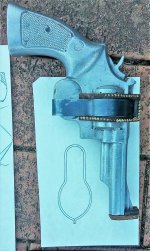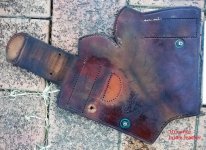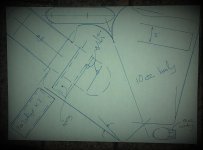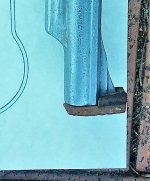rednichols
Member
- Joined
- Jul 24, 2012
- Messages
- 2,745
- Reaction score
- 8,484
Learned a bit more about Berns-Martin's Speed holster recently, by disassembling one. First thing: the spring itself is handsomely, professionally made. And still very strong after all these years. Little spots of rust but otherwise as if it was new; made of what's called 'blue-tempered clockspring' 3/4" wide x .040" thick. Perfection.
"All these years" could be since 1950 because this one is a K frame fitment (with a McGivern front sight, very tall) marked Evaluators; and 1950 is that company's founding year and also the year that Jack Martin reopened Berns-Martin after WWII, and roughly when both patents expired (so no royalties to pay).
Confirmed: the belt loop and the latigo sleeves for the spring are machine stitched and the two ends (guard and muzzle) are by hand. One tells with a destructive test in this case: cutting the seam open. If each stitch has short legged 'U' threads on both sides, it's hand stitched. If only one side does, and the other side's 'U' threads are caught on a long bobbin thread (strips out of the seam like unzipping a zipper) then machine sewn.
Thread is very fine; I'd have thought too fine and indeed I simply ripped the belt loop free, with my aged and arthritic hands.
The muzzle plugs were carefully tailored to order. This one was for a McGivern sight about .700" tall! Prior owner(s) had tried to use a conventionally sighted revolver in it, which causes the muzzle to sit on top of the special 'well' stapled onto the interior surface of the plug; and that forced the stitching at the guard to fail (revolver sat up too high by 6mm).
Holster body is made from 10 ounce bridle leather, the latigo (confirmed) is 7 ounce, that 'well' is 15 ounce. Sewing is 8 to the inch, which required a fine thread (or the converse). I may rebuild it in horsehide someday, for fun.
 The spring is in its actual, original position: centered exactly on the cylinder
The spring is in its actual, original position: centered exactly on the cylinder

 Make your own: have a local copy center print this so that the 1" dimension of the sleeves' stitchlines are actually 1"
Make your own: have a local copy center print this so that the 1" dimension of the sleeves' stitchlines are actually 1"
 I cut back the 'well' that's cupping the front sight, to accommodate an M19, to show how the plug functions. Turns out that plug is angled vs the forward lips of the holster, to trap the sight; because otherwise most front sights are behind the muzzle and the plug wouldn't function. Esp. on an SAA!
I cut back the 'well' that's cupping the front sight, to accommodate an M19, to show how the plug functions. Turns out that plug is angled vs the forward lips of the holster, to trap the sight; because otherwise most front sights are behind the muzzle and the plug wouldn't function. Esp. on an SAA!
"All these years" could be since 1950 because this one is a K frame fitment (with a McGivern front sight, very tall) marked Evaluators; and 1950 is that company's founding year and also the year that Jack Martin reopened Berns-Martin after WWII, and roughly when both patents expired (so no royalties to pay).
Confirmed: the belt loop and the latigo sleeves for the spring are machine stitched and the two ends (guard and muzzle) are by hand. One tells with a destructive test in this case: cutting the seam open. If each stitch has short legged 'U' threads on both sides, it's hand stitched. If only one side does, and the other side's 'U' threads are caught on a long bobbin thread (strips out of the seam like unzipping a zipper) then machine sewn.
Thread is very fine; I'd have thought too fine and indeed I simply ripped the belt loop free, with my aged and arthritic hands.
The muzzle plugs were carefully tailored to order. This one was for a McGivern sight about .700" tall! Prior owner(s) had tried to use a conventionally sighted revolver in it, which causes the muzzle to sit on top of the special 'well' stapled onto the interior surface of the plug; and that forced the stitching at the guard to fail (revolver sat up too high by 6mm).
Holster body is made from 10 ounce bridle leather, the latigo (confirmed) is 7 ounce, that 'well' is 15 ounce. Sewing is 8 to the inch, which required a fine thread (or the converse). I may rebuild it in horsehide someday, for fun.
 The spring is in its actual, original position: centered exactly on the cylinder
The spring is in its actual, original position: centered exactly on the cylinder
 Make your own: have a local copy center print this so that the 1" dimension of the sleeves' stitchlines are actually 1"
Make your own: have a local copy center print this so that the 1" dimension of the sleeves' stitchlines are actually 1" I cut back the 'well' that's cupping the front sight, to accommodate an M19, to show how the plug functions. Turns out that plug is angled vs the forward lips of the holster, to trap the sight; because otherwise most front sights are behind the muzzle and the plug wouldn't function. Esp. on an SAA!
I cut back the 'well' that's cupping the front sight, to accommodate an M19, to show how the plug functions. Turns out that plug is angled vs the forward lips of the holster, to trap the sight; because otherwise most front sights are behind the muzzle and the plug wouldn't function. Esp. on an SAA!
Last edited:
